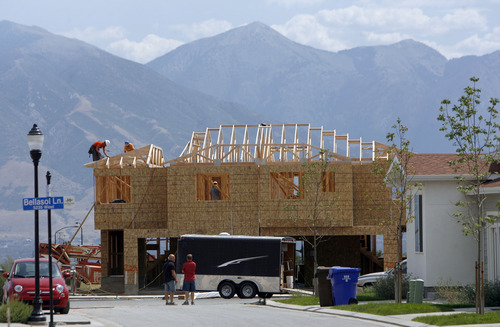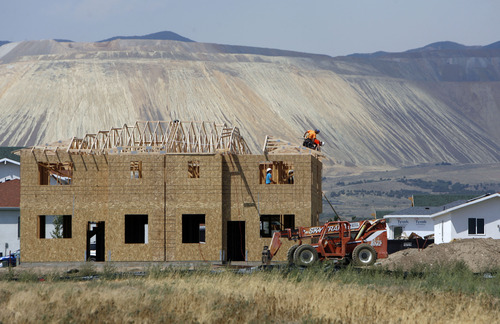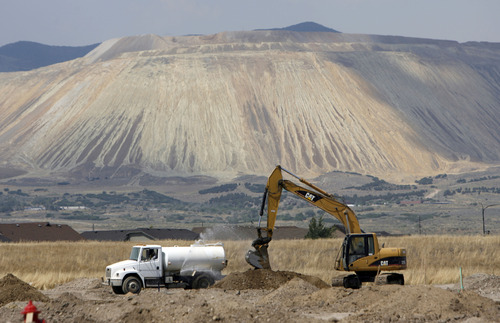This is an archived article that was published on sltrib.com in 2013, and information in the article may be outdated. It is provided only for personal research purposes and may not be reprinted.
A shortage of workers threatens Wasatch Front homebuilders just as buyer demand picks up after several brutal years of decline that pushed several construction firms out of business.
Builders say the deep recession in Utah forced many skilled and unskilled workers to find other ways to make a living or decamp to energy states like North Dakota, where homebuilding is on a brisk pace to keep up with the influx of oil workers.
Salt Lake City builders also blame the acrimonious immigration battle in Congress. Many Hispanic construction laborers went home during the recession when jobs in Utah dried up, and now either fear coming back or can't get work permits that would allow them to return. Construction employment is 30,000 below pre-recession levels, according to the state Department of Workforce Services.
Whatever the reason, the labor shortage is slowing down the pace of construction, raising fears of poor workmanship, and driving up the price of new single-family homes — at the same time interest rates are rising off historic lows.
"There is definitely a shortage right now. The severity is serious, and it's about to get worse," said Bruce Hanson, development director at Garbett Homes in Salt Lake City.
By most accounts, the Wasatch Front building industry is moving past the severe drop in housing construction, which helped to usher in the recession. The industry isn't fully back, builders say. But, starting last summer, it was clear to many local construction companies that consumers were coming back to the market. Their optimism was underscored Thursday by a National Association of Home Builders/Wells Fargo report that said confidence among U.S. homebuilders is at its highest level in nearly eight years.
"It starts with buying land," said Rene Oehlerking, Garbett's marketing director. "A year ago, I was bidding against one or two people. Now I'm bidding against 10 to 15 people. The amount of people who are in the market to buy land has drastically increased."
The surge of land buying has been good for Garbett, which expects to build 400 homes this year and 400 to 600 next year. But it's almost certain to aggravate the labor shortage unless a lot of experienced construction workers suddenly show up. That doesn't seem likely. Garbett is already two months behind schedule on a 174-unit project in Herriman because the company can't hire enough workers with the right skills, Hanson said.
"If he [Hanson] is telling you the labor shortage is severe now, it's going to be twice as severe next year because of all the land that we bought this year will ... be ready to build on next year," said Oehlerking, who added that prices his company charges homebuyers have jumped 10 percent since the start of 2013. He blamed rising labor costs and rising material costs in equal measure.
Clark Ivory, CEO of Ivory Homes, the largest homebuilder and land developer in Utah, said the labor shortages his company faced in the spring has eased some, but is still "challenging" for his company, which is on track to sell more than 700 houses this year.
"Particularly in areas of skilled labor," Ivory said. "It is not challenging now to find the guys that are unskilled. It is more difficult to find the journeymen — plumbers, electricians, the framers and the really skilled drywallers."
Ivory said many competent construction workers have gone into other industries. A lot of the highly skilled Latinos employed by his company or by subcontractors who work for Ivory Homes have returned to Mexico or other Latin American companies. None who worked for Ivory was undocumented, he said.
"Much of this trade base came here legally, hoping they would get a chance [for] citizenship," said Ivory, an outspoken advocate of immigration reform. He believes the impasse in Washington is hurting the construction business.
"Many legal and illegal workers, I believe, left during the more challenging past few years because there was less work available and the unfriendliness of the immigration system," Ivory said. "And now they are not coming back. We've got a situation where some of our most skilled labor that left are not coming back."
The dearth of skilled craftsmen is being magnified by a shortage of people graduating from technical schools, Ivory said. When the construction industry turned down, he added, fewer young people decided to go to school to learn a trade.
Trade schools "are hardly graduating anybody right now," Ivory said.
If Ivory Homes does sell 700 homes this year, that will be a 25 percent jump over 2012. Clark Ivory expects that pace to slow some in 2014, in part because a rate of growth that fast isn't sustainable or healthy. But, he added, there is another reason. His company is leery about speeding up construction because there aren't enough trained workers available.
Gordon Wood, who owns Professional Building Group in Saratoga Springs, said many skilled workers who moved to other occupations during the construction downturn are afraid to return to their old jobs.
"They are nervous about coming back. I've been looking for two weeks for some qualified guys," Wood said. " If you are looking for cheap labor, you can find it. But to find qualified guys, it's difficult."
Twitter: @sltribpaul —
Vendion parchic tes sunt eostionse volecer oremquam, comnietur rerspicia consed.











